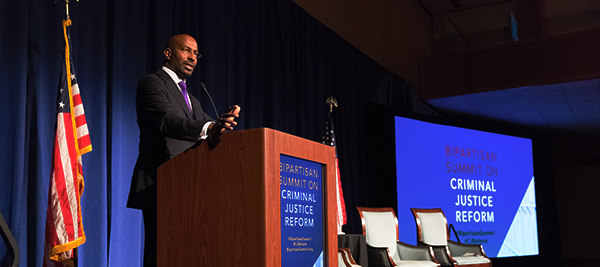What Factors Affect Americans’ Perception of Whether Crime is Increasing or Decreasing?
More Americans today think that crime is decreasing than any year since 2005 even when it isn’t. Where do these ideas about crime come from? In a country inhabited by over 318 million people that spans over 3.79 million square miles, where the average person has only 5.1 hours of leisure time a day and spends 2.8 hours of that time watching TV, anyone would be hard-pressed to keep track of the whole of U.S. crime on their own (American Time Use Survey). In June’s Public Opinion Monthly, we’ll be looking at perceptions of crime, how they change, and their origin.
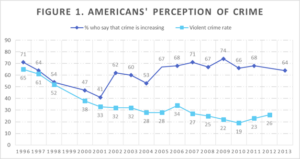
*Violent crime rate is the number of victimizations per 1,000 households that occurred during the year. Source: Bureau of Justice Statistics, National Crime Victimization Survey, 1996-2012.
Belief that crime had increased “in the last year” dramatically declined in the 1990’s, from 71% in 1996 to 41% in 2001, running parallel with the decline in actual violent crime victimization rates (from 65% in 1996 to 33% in 2001) (Saad, 2013). However, shortly after September 11, 2001, opinion that crime was increasing quickly shot back up and remained above 50%, with a peak of 74% in 2009, despite continued decreasing crime rates. More recently, despite the setback in battling crime in the past two years, Americans are slightly more, rather than less, positive about the crime rate. Most interestingly, different demographic groups perceive the crime rate differently.
When it comes to where the public gets its information about crime, it turns out that local news is highly influential in shaping public views on crime and who is involved with crime. It seems that for 76 percent of Americans, those 2.8 hours of TV time a day are where opinions about crime are formed, compared to 22 percent who say that they form these opinions based on personal experience. Furthermore, survey results demonstrating that the public uses the news to help form their opinions about crime are consistent with findings from communications research studies that show that the news media also help shape not only what people think about, but how they think about it, and what solutions seem desirable (Dorfman & Schiraldi, 2001). This makes sense: because you cannot possibly keep up to date with everything that’s going on in the country, you must rely on other sources, hopefully ones that you trust, to gather information for you, and vet and frame the types of stories that they feature.
Unfortunately, this equation has problems. First and foremost, regardless of whether you rely on the media or personal experience to inform your opinion, your best guess about crime in the United States is most likely wrong, as the majority believe the opposite of what is actually occurring. Although crime has steadily decreased since the mid-nineties, the majority of U.S. adults believe that crime is on the rise. You’d expect this growing belief in the increasing prevalence of crime to spark more concern for criminal justice reform, however, I am afraid that’s not the case. Despite the perceptions of rising crime rates, the public continues to place a very low priority on crime as a national issue compared to other important issues facing the country. When crime is listed with other important issues facing the country, since 2000 only 0.5-3% believe crime is the most important problem facing the nation (Hindelang Criminal Justice Research Center, 2011).
Demographic shifts in the perception of crime from 2003-2011
Let’s walk through a series of charts showing some interesting demographic differences in the perception of crime from 2003 through 2011.
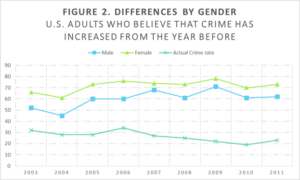
Source: Data provided by The Gallup is used in all charts.
The above chart shows the differences between men’s and women’s perceptions of the crime rate in the United States (Saad, 2013). For every year spanning this survey, more women believe that crime is increasing than men, but both genders largely seem to shift perceptions together.
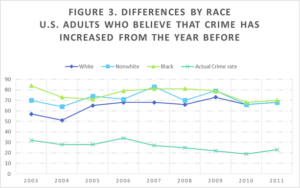
The above chart shows differences in perceptions of the crime rate between Whites, Nonwhites, and Blacks as they change over time. While the three groups have more or less come to a consensus in recent years, historically Whites were the least likely to say that crime is increasing, and Blacks were the most likely.
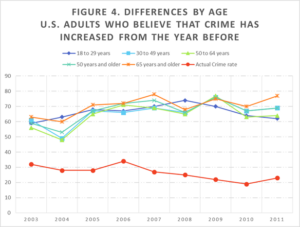
The above chart shows the percentage of U.S. adults who believe that there is more crime in the U.S. now than one year ago, separated by age. As you can see above, it seems that age does not play a major role in predicting your perception of crime, with almost all age groups believing that crime is increasing about equally. However, unlike the other age groups, it is the youngest generation that believes that crime has decreased steadily since 2008.
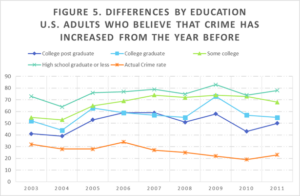
The above chart shows how educational attainment makes a big difference on how you perceive the change in the crime rate from year to year in the United States. Those that have attended college and beyond are the most likely to say that there is less crime than there was the previous year. On the other hand, the less educational attainment you have, the more likely you are to believe that crime is increasing.
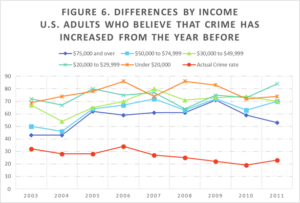
The above chart shows how differences in income affect the way that U.S. adults perceive the change in crime in the country. It appears the those with the lowest incomes are the most likely to believe that there is more crime than there was a year ago, while those in the highest income brackets are more likely to state that there is less crime.
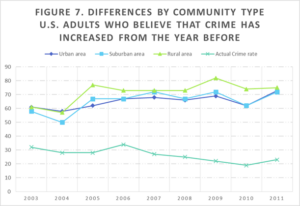
The above chart shows how community type may contribute to how you perceive crime in the United States. Over the past decade, those from rural areas are the most likely to believe that crime is on the rise, while those from urban and suburban areas are generally very similar in their perceptions of crime between 2003 and 2011. In recent years these three groups have more or less coincided with equal parts of their populations believing that crime is increasing in the country.
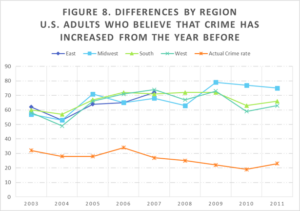
The above chart shows how geographic region may contribute to how you perceive crime, showing that all areas of the United States are more or less similar in their assessments of the change in crime rate over this period of time. However, after 2009 the Midwest takes the lead as the region with the greatest population of people who believe that crime is on the rise.
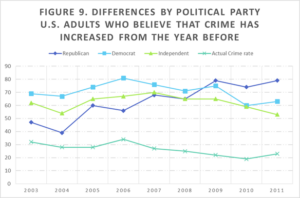
This last chart shows how your political party plays a role in whether or not you believe that there is more crime in the United States now than there was a year ago. Toward the beginning of the survey time period, between 2003 and 2007, Democrats were the most likely to believe that crime was increasing and Republicans were most likely to believe that crime was decreasing. Between 2007 and 2011 there was a change, as those that identified as Republican increasingly believed that crime was on the rise. In 2009, Republicans became the group that most believed that crime was increasing in the country, and Independents were least likely to believe that crime was increasing.
Clearly, we can’t all be right.
It seems that no matter how you slice it, the way that we receive our information about crime in the United States is leading us, as a nation, to believe that U.S. crime is up instead of down. What’s more – different groups perceive crime in different ways. Republicans, for example, have steadily believed that crime is on the rise since 2003, while Democrats and Independents believe the opposite. Recent research suggests that this may have to do with who is in office and perceptions about how tough they are on crime. Additionally, perceptions about crime that change along party lines may also have to do with whether or not you agree with the policy positions of your elected officials. It’s also possible that these differences are a consequence of where these groups get news about crime.
On another subject, why do so many more women believe that crime is increasing compared to men? Does it have to do with personal experience and fear of victimization? Research shows that with respect to the prospect of victimization, there is a consistent and substantial disparity in the perspectives of women and men. Perhaps this disparity is related to the disparity that we see in perceptions of crime in the U.S.
Finally, why would those with the lowest educational attainment believe that crime is increasing to a much greater degree than those who’ve achieved higher education? And why would those with the lowest incomes perceive crime to be greatest, while those with the highest incomes perceive there to be much less crime in the United States? Could these trends have something to do with the different personal experiences of people within these different groups?
These are questions that we need to answer as a nation. They matter because we use what we think we know about the world to inform decisions seeking to improve it. If certain groups perceive crime to be higher because they are disproportionately targeted as victims of crime – then we need to seriously consider policy to help protect all citizens. If certain populations are lacking resources to prevent and control crime in their neighborhoods – we should work to provide the resources necessary to curb crime rates. On the other hand, if our perceptions about crime are largely derived from the media we consume, and that media is also capable of not only helping us shape what we think about, but how we think about it, and what solutions seem desirable, we need to be more aware of the media we consume. Media stories are able to shape public opinion in ways that can make a significant impact on the policy decisions we make as a country. We must strive to hold the media accountable to portray accurate information that we can use to help form these opinions and create policy that will move this country closer to its ideals of equality and justice for all.
References
Bureau of Labor Statistics, American Time Use Survey (Data includes all persons age 15 and over. Data include all days of the week and are annual averages for 2012).
Dorfman, L., & Schiraldi, V. (2001). Off Balance: Youth, Race, and Crime in the News. Building Blocks for Youth.
Saad, L. (2013 October 31). US Crime is Up, but Americans Don’t Seem to Have Noticed.
Hindelang Criminal Justice Research Center. (2011). Sourcebook of Criminal Justice Statistics.


